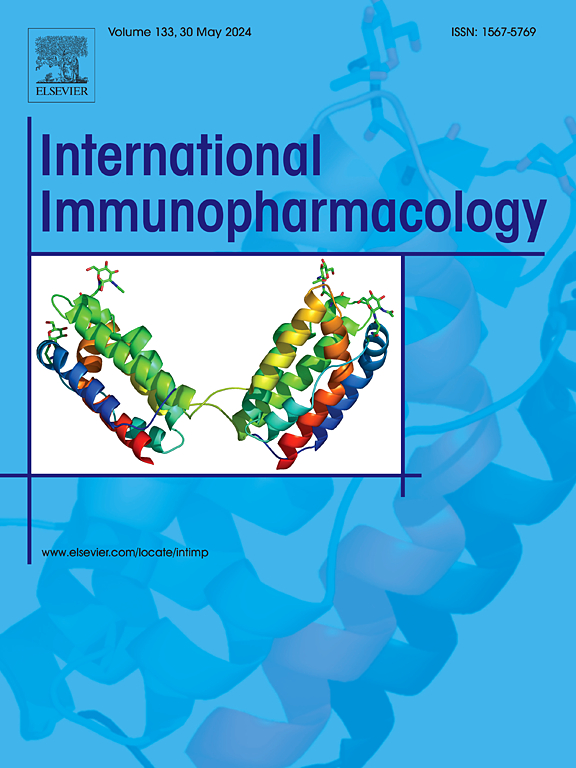Causal effects of circulating inflammatory proteins on oral phenotypes: Deciphering immune-mediated profiles in the host-oral axis
IF 4.7
2区 医学
Q2 IMMUNOLOGY
引用次数: 0
Abstract
Background
Oral manifestations function as precursors to potential systemic pathologies, signaling early indicators of underlying health complications or immunological dysfunctions. Within these dynamics, circulating inflammatory proteins are recognized as critical mediators in immunopharmacology, bridging holistic health, immune response, and oral health.
Methods
We employed genetic data from genome-wide association studies to perform comprehensive Mendelian randomization (MR) analyses on 91 circulating inflammatory proteins and 17 oral phenotypes. Six MR algorithms and five auxiliary control measures were utilized to estimate the causal effects. Subsequently, the MR-Bayesian model averaging (MR-BMA) approach was conducted to elucidate the priorities in host-oral communication, followed by network analyses to explore the interactions among phenotypes.
Results
After multiple corrections, MR identified five genetically predicted proteins associated with oral phenotypes. Specifically, FGF21 was correlated with Nteeth and DMFS; hGDNF with gingival pain; CCL4 with stomatitis; and S100A12 with denture use. The causal associations remained robust in sensitivity analyses. Nine protein-phenotype clusters were prioritized using MR-BMA. Among these, S100A12, FGF19, FGF21, and CCL4 exhibited extensive correlations with various oral phenotypes.
Conclusions
Our study offers novel genetic insights into the causal relationships, prioritizations, and connections between circulating inflammatory proteins and oral phenotypes. These findings comprehensively depict immune-mediated proteomic profiles underlying the host-oral axis, providing significant implications for clinical practice, public health, and immunopharmacology.
循环炎症蛋白对口腔表型的因果效应:解密宿主-口腔轴的免疫介导特征。
背景:口腔表现是潜在全身性病变的前兆,是潜在健康并发症或免疫功能障碍的早期信号。在这些动态变化中,循环炎症蛋白被认为是免疫药理学的关键介质,是连接整体健康、免疫反应和口腔健康的桥梁:我们利用全基因组关联研究的遗传数据,对 91 种循环炎症蛋白和 17 种口腔表型进行了全面的孟德尔随机化(MR)分析。利用六种 MR 算法和五种辅助控制措施来估计因果效应。随后,采用 MR-Bayesian 模型平均(MR-BMA)方法阐明了宿主与口腔交流的优先顺序,并通过网络分析探讨了表型之间的相互作用:结果:经过多重校正,MR 发现了五个与口腔表型相关的基因预测蛋白。具体来说,FGF21与Nteeth和DMFS相关;hGDNF与牙龈疼痛相关;CCL4与口腔炎相关;S100A12与义齿使用相关。在敏感性分析中,这些因果关系仍然保持稳定。使用 MR-BMA 对九个蛋白质表型群进行了优先排序。其中,S100A12、FGF19、FGF21 和 CCL4 与各种口腔表型具有广泛的相关性:我们的研究为循环炎症蛋白与口腔表型之间的因果关系、优先顺序和联系提供了新的遗传学见解。这些发现全面描述了宿主-口腔轴的免疫介导蛋白质组概况,对临床实践、公共卫生和免疫药理学具有重要意义。
本文章由计算机程序翻译,如有差异,请以英文原文为准。
求助全文
约1分钟内获得全文
求助全文
来源期刊
CiteScore
8.40
自引率
3.60%
发文量
935
审稿时长
53 days
期刊介绍:
International Immunopharmacology is the primary vehicle for the publication of original research papers pertinent to the overlapping areas of immunology, pharmacology, cytokine biology, immunotherapy, immunopathology and immunotoxicology. Review articles that encompass these subjects are also welcome.
The subject material appropriate for submission includes:
• Clinical studies employing immunotherapy of any type including the use of: bacterial and chemical agents; thymic hormones, interferon, lymphokines, etc., in transplantation and diseases such as cancer, immunodeficiency, chronic infection and allergic, inflammatory or autoimmune disorders.
• Studies on the mechanisms of action of these agents for specific parameters of immune competence as well as the overall clinical state.
• Pre-clinical animal studies and in vitro studies on mechanisms of action with immunopotentiators, immunomodulators, immunoadjuvants and other pharmacological agents active on cells participating in immune or allergic responses.
• Pharmacological compounds, microbial products and toxicological agents that affect the lymphoid system, and their mechanisms of action.
• Agents that activate genes or modify transcription and translation within the immune response.
• Substances activated, generated, or released through immunologic or related pathways that are pharmacologically active.
• Production, function and regulation of cytokines and their receptors.
• Classical pharmacological studies on the effects of chemokines and bioactive factors released during immunological reactions.

 求助内容:
求助内容: 应助结果提醒方式:
应助结果提醒方式:


